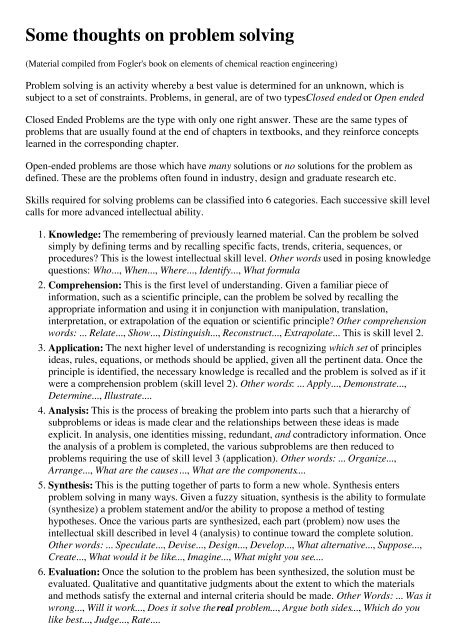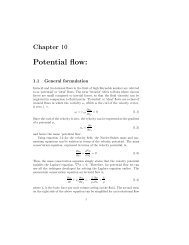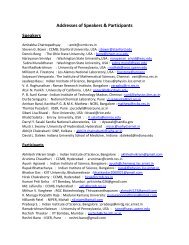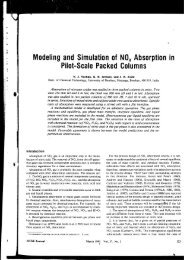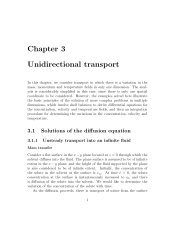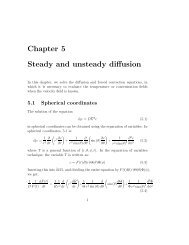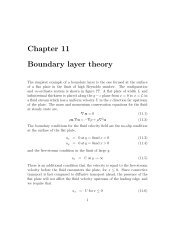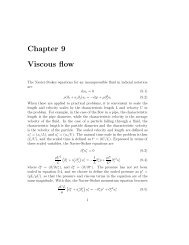Some thoughts on problem solving - Chemical Engineering ...
Some thoughts on problem solving - Chemical Engineering ...
Some thoughts on problem solving - Chemical Engineering ...
You also want an ePaper? Increase the reach of your titles
YUMPU automatically turns print PDFs into web optimized ePapers that Google loves.
<str<strong>on</strong>g>Some</str<strong>on</strong>g> <str<strong>on</strong>g>thoughts</str<strong>on</strong>g> <strong>on</strong> <strong>problem</strong> <strong>solving</strong><br />
(Material compiled from Fogler's book <strong>on</strong> elements of chemical reacti<strong>on</strong> engineering)<br />
Problem <strong>solving</strong> is an activity whereby a best value is determined for an unknown, which is<br />
subject to a set of c<strong>on</strong>straints. Problems, in general, are of two types: Closed ended or Open ended<br />
Closed Ended Problems are the type with <strong>on</strong>ly <strong>on</strong>e right answer. These are the same types of<br />
<strong>problem</strong>s that are usually found at the end of chapters in textbooks, and they reinforce c<strong>on</strong>cepts<br />
learned in the corresp<strong>on</strong>ding chapter.<br />
Open-ended <strong>problem</strong>s are those which have many soluti<strong>on</strong>s or no soluti<strong>on</strong>s for the <strong>problem</strong> as<br />
defined. These are the <strong>problem</strong>s often found in industry, design and graduate research etc.<br />
Skills required for <strong>solving</strong> <strong>problem</strong>s can be classified into 6 categories. Each successive skill level<br />
calls for more advanced intellectual ability.<br />
1. Knowledge: The remembering of previously learned material. Can the <strong>problem</strong> be solved<br />
simply by defining terms and by recalling specific facts, trends, criteria, sequences, or<br />
procedures This is the lowest intellectual skill level. Other words used in posing knowledge<br />
questi<strong>on</strong>s: Who..., When..., Where..., Identify..., What formula<br />
2. Comprehensi<strong>on</strong>: This is the first level of understanding. Given a familiar piece of<br />
informati<strong>on</strong>, such as a scientific principle, can the <strong>problem</strong> be solved by recalling the<br />
appropriate informati<strong>on</strong> and using it in c<strong>on</strong>juncti<strong>on</strong> with manipulati<strong>on</strong>, translati<strong>on</strong>,<br />
interpretati<strong>on</strong>, or extrapolati<strong>on</strong> of the equati<strong>on</strong> or scientific principle Other comprehensi<strong>on</strong><br />
words: ... Relate..., Show..., Distinguish..., Rec<strong>on</strong>struct..., Extrapolate... This is skill level 2.<br />
3. Applicati<strong>on</strong>: The next higher level of understanding is recognizing which set of principles<br />
ideas, rules, equati<strong>on</strong>s, or methods should be applied, given all the pertinent data. Once the<br />
principle is identified, the necessary knowledge is recalled and the <strong>problem</strong> is solved as if it<br />
were a comprehensi<strong>on</strong> <strong>problem</strong> (skill level 2). Other words: ... Apply..., Dem<strong>on</strong>strate...,<br />
Determine..., Illustrate....<br />
4. Analysis: This is the process of breaking the <strong>problem</strong> into parts such that a hierarchy of<br />
sub<strong>problem</strong>s or ideas is made clear and the relati<strong>on</strong>ships between these ideas is made<br />
explicit. In analysis, <strong>on</strong>e identities missing, redundant, and c<strong>on</strong>tradictory informati<strong>on</strong>. Once<br />
the analysis of a <strong>problem</strong> is completed, the various sub<strong>problem</strong>s are then reduced to<br />
<strong>problem</strong>s requiring the use of skill level 3 (applicati<strong>on</strong>). Other words: ... Organize...,<br />
Arrange..., What are the causes ..., What are the comp<strong>on</strong>ents....<br />
5. Synthesis: This is the putting together of parts to form a new whole. Synthesis enters<br />
<strong>problem</strong> <strong>solving</strong> in many ways. Given a fuzzy situati<strong>on</strong>, synthesis is the ability to formulate<br />
(synthesize) a <strong>problem</strong> statement and/or the ability to propose a method of testing<br />
hypotheses. Once the various parts are synthesized, each part (<strong>problem</strong>) now uses the<br />
intellectual skill described in level 4 (analysis) to c<strong>on</strong>tinue toward the complete soluti<strong>on</strong>.<br />
Other words: ... Speculate..., Devise..., Design..., Develop..., What alternative..., Suppose...,<br />
Create..., What would it be like..., Imagine..., What might you see....<br />
6. Evaluati<strong>on</strong>: Once the soluti<strong>on</strong> to the <strong>problem</strong> has been synthesized, the soluti<strong>on</strong> must be<br />
evaluated. Qualitative and quantitative judgments about the extent to which the materials<br />
and methods satisfy the external and internal criteria should be made. Other Words: ... Was it<br />
wr<strong>on</strong>g..., Will it work..., Does it solve the real <strong>problem</strong>..., Argue both sides..., Which do you<br />
like best..., Judge..., Rate....
A simple heuristic algorithm for <strong>solving</strong> close ended<br />
<strong>problem</strong>s<br />
1. Write out the <strong>problem</strong> statement. Include informati<strong>on</strong> <strong>on</strong> what you are to solve, and c<strong>on</strong>sider<br />
why you need to solve the <strong>problem</strong>.<br />
2. Make sure you are <strong>solving</strong> the real <strong>problem</strong> as opposed to the perceived <strong>problem</strong>. Use<br />
techniques such as Finding out Where the Problem Came From<br />
3. Draw and label a sketch. Define and name all variables and/or symbols. Show numerical<br />
values of variables if known.<br />
4. Identify and name: Relevent principles, theories and equati<strong>on</strong>s, Systems and subsytems,<br />
Dependent and independent variables, Knowns and unknowns, Inputs and outputs,<br />
Necessary (missing) informati<strong>on</strong><br />
5. List assumpti<strong>on</strong>s and approximati<strong>on</strong>s involved in <strong>solving</strong> the <strong>problem</strong>. Questi<strong>on</strong> the<br />
assumpti<strong>on</strong>s and then state which <strong>on</strong>es are the most reas<strong>on</strong>able for your purposes.<br />
6. Check to see if the <strong>problem</strong> is either under-specified or over-specified. If it is<br />
under-specified, figure out how to find the missing informati<strong>on</strong>. If over-specified, identify<br />
the extra informati<strong>on</strong> that isn't needed.<br />
7. Relate <strong>problem</strong> to a similar <strong>problem</strong> or experience (compare to an example <strong>problem</strong> in<br />
lecture or in the book).<br />
8. Develop/derive/integrate and/or manipulate an equati<strong>on</strong> or equati<strong>on</strong>s from which the desired<br />
variable can be determined<br />
9. Substitute numerical values and calculate the desired variable. Check your units at each step<br />
in the soluti<strong>on</strong> to find possible errors.<br />
10. Examine and evaluate the answer to see it makes sense. Is it reas<strong>on</strong>able, c<strong>on</strong>sidering the<br />
<strong>problem</strong> statement<br />
What if you are stuck<br />
Very often <strong>on</strong>e finds that no progress is being made and you are stuck. D<strong>on</strong>'t worry, you are not<br />
al<strong>on</strong>e. Everybody goes through such stages. Here are few tips which may help you overcome this<br />
stage<br />
1. Persevere! Keep trying different strategies and stay open to creative ideas. Try not to get<br />
frustrated.<br />
2. Be more active in the soluti<strong>on</strong>!! Ask yourself questi<strong>on</strong>s about the <strong>problem</strong>. Is this <strong>problem</strong> a<br />
routine <strong>on</strong>e What data are missing What equati<strong>on</strong>s can I use Explore the <strong>problem</strong>. Draw<br />
sketches of what you think that the soluti<strong>on</strong> should look like. Write equati<strong>on</strong>s. Keep track of<br />
your progress.<br />
3. Re-focus <strong>on</strong> the fundamentals. Review the textbook and lecture material. Look for similar<br />
examples. Study the examples given. Change what is given in the example and what is<br />
asked, then try to see how it might relate to the <strong>problem</strong> you are addressing.<br />
4. Break the <strong>problem</strong> into parts. Analyze the parts of the <strong>problem</strong>. C<strong>on</strong>centrate <strong>on</strong> the parts of<br />
the <strong>problem</strong> you understand and that can be solved.<br />
5. Verbalize the <strong>problem</strong> to yourself and others. Describe... what the <strong>problem</strong> is what you have<br />
d<strong>on</strong>e, and where you are stuck
6. Paraphrase. Re-describe the <strong>problem</strong>. Think of simpler ways to describe the <strong>problem</strong>. Ask<br />
others to describe the <strong>problem</strong> to you in their own words.<br />
7. Look at extreme cases that could give insight and understanding. For instance: What<br />
happens if x = 0 x = infinity<br />
8. Simplify the <strong>problem</strong> and solve a limiting case. Break up the <strong>problem</strong> into simpler pieces<br />
and solve each piece by itself. Find a related but simpler example and work from there.<br />
9. Look for hidden assumpti<strong>on</strong>s or for what informati<strong>on</strong> you have forgotten to use. After<br />
reading each phrase or sentence of the <strong>problem</strong> statement, ask yourself if any assumpti<strong>on</strong>s<br />
can be inferred from that phrase.<br />
10. Alternate working forward towards a soluti<strong>on</strong> and backwards from a soluti<strong>on</strong> you assumed.<br />
Working backwards may at least give you clues as to how you should approach the <strong>problem</strong><br />
while working forward.<br />
11. Take a break. Incubate. Let your subc<strong>on</strong>scious work <strong>on</strong> the <strong>problem</strong> while you do something<br />
else, like exercising, talking to friends, or just relaxing! <str<strong>on</strong>g>Some</str<strong>on</strong>g>times all you need is a break to<br />
achieve that final breakthrough!<br />
<str<strong>on</strong>g>Some</str<strong>on</strong>g> ideas for dealing with open ended <strong>problem</strong>s<br />
1. Write an initial <strong>problem</strong> statement. Include informati<strong>on</strong> <strong>on</strong> what you are to solve, and<br />
c<strong>on</strong>sider why you need to solve the <strong>problem</strong>.<br />
2. Make sure you are proceeding to solve the real <strong>problem</strong> as opposed to the perceived <strong>problem</strong><br />
Find out where the <strong>problem</strong> came from, Explore the <strong>problem</strong>.<br />
3. Generate soluti<strong>on</strong>s Understand what c<strong>on</strong>ceptual blocks can occur so that you will be aware<br />
of them when they surface. Try Analogy: State the <strong>problem</strong>, Generate analogies, Solve the<br />
analogy, Transfer the analogy to the soluti<strong>on</strong>. Organize the ideas/soluti<strong>on</strong>s that have been<br />
generated. Today's c<strong>on</strong>straints (e.g. computing speed, communicati<strong>on</strong>s) may be limiting the<br />
generati<strong>on</strong> of creative soluti<strong>on</strong>s. Think to the future when these c<strong>on</strong>straints may no l<strong>on</strong>ger<br />
exist. Remove all possible c<strong>on</strong>straints from the <strong>problem</strong> statement and soluti<strong>on</strong> criteria. Take<br />
a break. Let your subc<strong>on</strong>scious work <strong>on</strong> the <strong>problem</strong> while you do something else.<br />
<str<strong>on</strong>g>Some</str<strong>on</strong>g>times all you need is a breather to achieve that final breakthrough!<br />
4. Choose best alternative from the ideas generated (chapter 5) Decisi<strong>on</strong> Making: Musts,<br />
Wants, Adverse C<strong>on</strong>sequences Planning: Potential Problem, C<strong>on</strong>sequences, Preventative<br />
Acti<strong>on</strong>, C<strong>on</strong>tingent Acti<strong>on</strong>.<br />
5. Evaluati<strong>on</strong> - Is the <strong>problem</strong> you are <strong>solving</strong> still relevant Does the soluti<strong>on</strong> satisfy all the<br />
stated and implied criteria<br />
<str<strong>on</strong>g>Some</str<strong>on</strong>g>thing about creative thinking<br />
1. Keep track of your ideas at all times. Many times ideas come at unexpected times. If an idea<br />
is not written down within 24 hours it will usually be forgotten<br />
2. Pose new questi<strong>on</strong>s to yourself every day. An inquiring mind is a creatively active <strong>on</strong>e that<br />
enlarges its area of awareness.<br />
3. Keep abreast of your field. Read the magazines, trade journals, and other literature in your<br />
field to make sure you are not using yesterday's technology to solve toady's <strong>problem</strong>s.<br />
4. Engage in creative hobbies. Hobbies can also help you relax. An active mind is necessary for<br />
creative growth.
5. Have courage and self-c<strong>on</strong>fidence. Be a paradigm pi<strong>on</strong>eer. Assume that you can and will<br />
indeed solve the <strong>problem</strong> Persist and have the tenacity to overcome obstacles that block the<br />
soluti<strong>on</strong> pathway.<br />
6. Learn to know and understand yourself. Deepen your self-knowledge by learning your real<br />
strengths, skills, weaknesses, dislike, biases, expectati<strong>on</strong>s, fears and prejudices.<br />
7. Learn about things outside your specialty. Use cross-fertilizati<strong>on</strong> to bring ideas and c<strong>on</strong>cepts<br />
from <strong>on</strong>e field or specialty to another.<br />
8. Avoid rigid, set patterns of doing things. Overcome biases and prec<strong>on</strong>ceived noti<strong>on</strong>s by<br />
looking at the <strong>problem</strong> from a fresh view point, always developing at least two or more<br />
alternative soluti<strong>on</strong>s to your <strong>problem</strong>.<br />
9. Be open and receptive to ideas (yours and others). New ideas are fragile; keep them from<br />
breaking by seizing <strong>on</strong> the tentative, half formed c<strong>on</strong>cepts and possibilities and developing<br />
them.<br />
10. Be alert in your observati<strong>on</strong>s. Look for similarities, differences, as well as unique and<br />
distinguishing features in situati<strong>on</strong>s and <strong>problem</strong>s.<br />
11. Adopt a risk taking attitude. Fear of failure is the major impediment to generating soluti<strong>on</strong>s<br />
which are risky (i.e., small chance of succeeding) but would have a major impact if they are<br />
successful. Outlining the ways you could fail and how you would deal with these failures<br />
will reduce this obstacle to creativity.<br />
12. Keep your sense of humor. You are more creative when you are relaxed. Humor aids in<br />
putting your <strong>problem</strong>s (and yourself) in perspective. Many times it relieves tensi<strong>on</strong> and<br />
makes you more relaxed.


